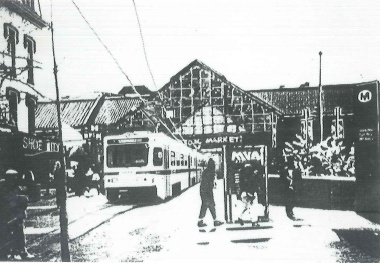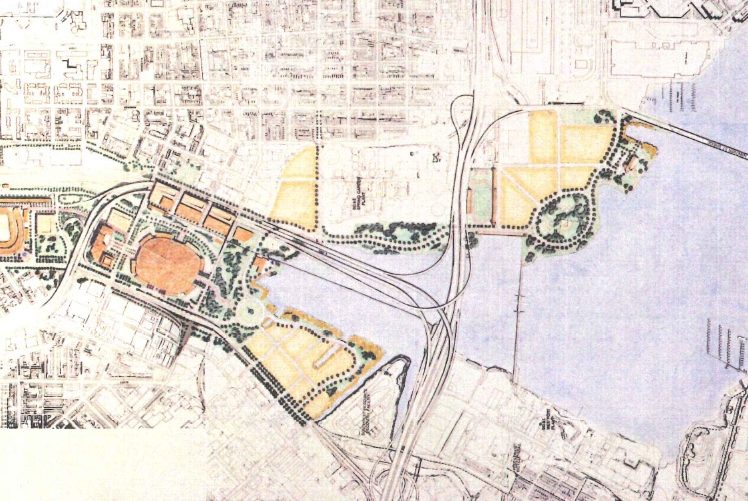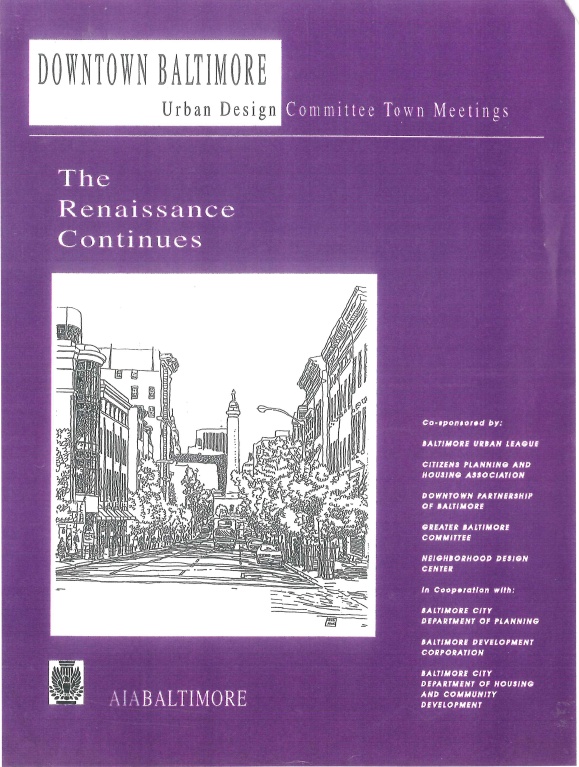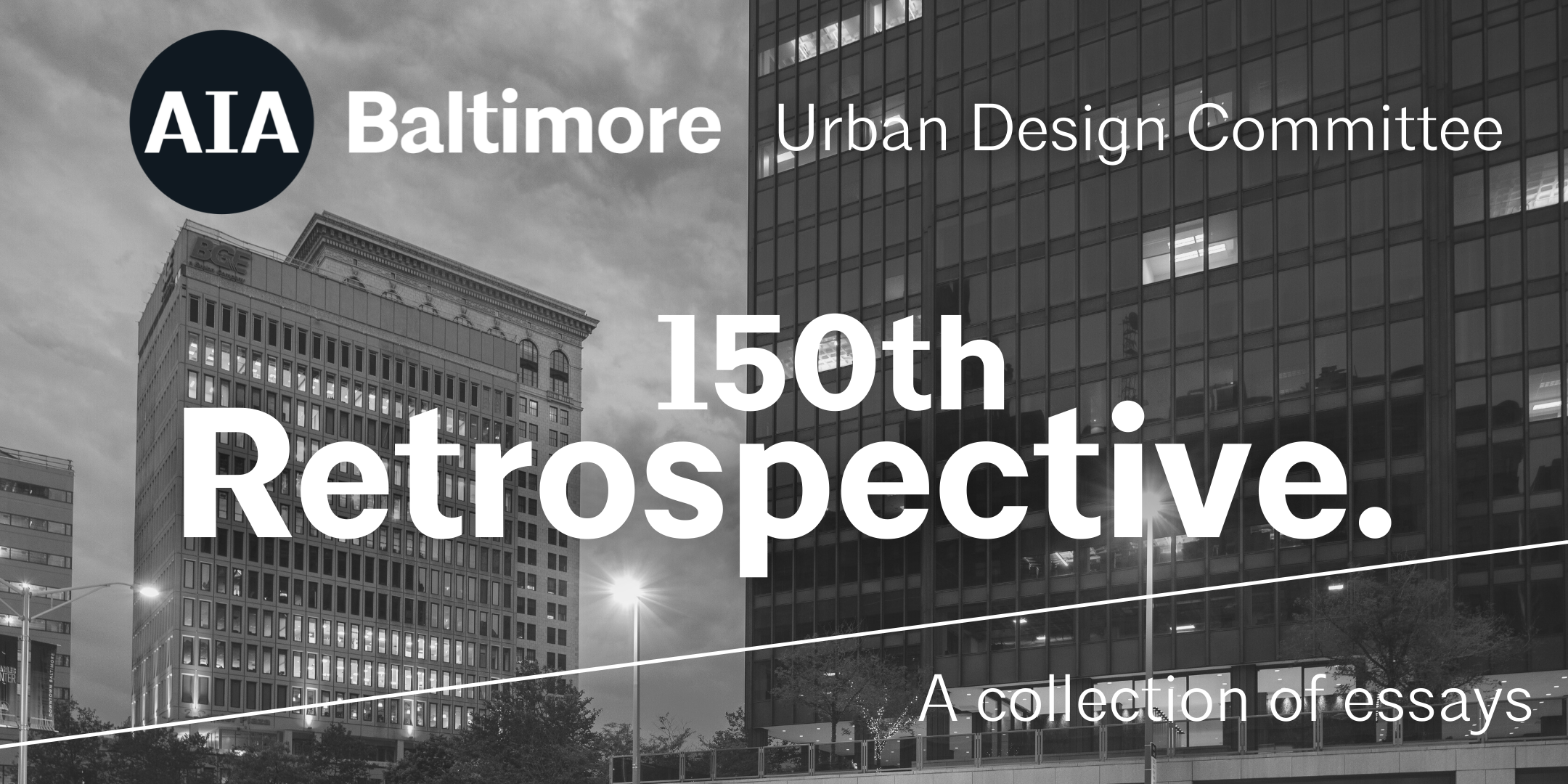AIA Urban Design Committee 150 Year Retrospective:
What Motivated My Participation In The Urban Design Committee
By: Klaus Philipsen, FAIA
In the long 150 years story of AIA Baltimore, the Urban Design Committee (UDC) covers only the last quarter of that period. 150 years ago nobody spoke about urban design and it wasn’t an academic endeavor, degree or syllabus. As a result, urban design is often seen as isolated from architecture as if any urban building could be designed and conceived without looking at the nearest street, the block, and the quarter in which it sits.
The late 1960s were a time of great turbulence in which it wasn’t enough any longer to be part of a distinguished professional organization, not enough to receive benefit from an exquisite network, not even enough to share professional wisdom with the young who are today called “emerging professionals”. Change was in the air, even a whiff of revolution. The Civil Rights movement had gripped the country followed by anti-Vietnam War demonstrations and a cultural revolution rocking the post-WWII consumer society in which urban flight had shifted attention away from cities to the suburbs. Architects began to search for ways how they could help shape the future and give back to society. It was at that time that AIA Baltimore spawned the Neighborhood Design Center. The NDC tells this history on its website:
On June 24, 1968, in the midst of the civil rights movement, Whitney M. Young, Executive Director of the Urban League, stepped to the podium to address the 100th Convention of the American Institute of Architects.
“You are distinguished by your thundering silence” in the face of urban disintegration, he challenged. “You share responsibility for the mess we are in.” His words were not comforting, nor were they meant to be. “Get involved in helping cities rebuild,” he said, “or risk the consequences”. From Young’s challenge sprang a national call to arms among architects, and nonprofit “design centers” opened in cities across the United States.

A Westside transit extension. Rendering by Urban Design Committee
In the fall of that same year, a group of architects in Baltimore took this challenge and began working with low and moderate income communities to rebuild after the riots and white flight that swept the city in the wake of Martin Luther King’s assassination. Thus was the birth of the Neighborhood Design Center.
According to the obituary for George Van Fossen ‘Van’ Schwab, FAIA the “group of architects” consisted of him and the late architect George E. Kostritsky, AIA, who in 1968 traveled to Philadelphia to study a volunteer design program that provided free design services to inner-city neighborhoods. This investigation led to the founding of the Neighborhood Design Center in Baltimore.
But the creation of NDC, again moved the engagement away from the AIA sphere. The new-found focus on minority rights, the environment, and the perils of auto-centric urban renewal had created a battle against urban freeways in which the future of the city was decided. Some architects were themselves change agents. With the Highway to Nowhere largely planned and designed and seemingly unavoidable, architects worked on linking the transportation project with transit and community improvement. Urban Renewal was in full swing at Charles Center and at the Inner Harbor, good architecture, as well as a focus on master planning for the larger area.
Nevertheless, it wasn’t until 1985 that AIA Baltimore formed its own Urban Design Committee, meeting at the Chapter House to create a voice to be heard, not to consider individual buildings but the design of the city. The occasion was the demolition of the historic Mercantile and Trust Building on South Street. To prevent similar demolitions UDC prepared jointly with Baltimore Heritage “Guidelines for Preservation and New Construction” for Redwood Street in 1989. The Guidelines could not prevent the much later demolition of the Southern Hotel on Redwood Street.
My motivation to check out AIA Baltimore was based on my experiences in my birthplace in Germany, where I had studied and then practiced architecture in Stuttgart. I had been a student leader and a borough council member fighting for a tamed version of urban renewal that replaced destruction with preservation. Stuttgart can be thought of as a German Detroit that has kept its mojo. It is and was a car city where Mercedes and Porsche are at home. It is there where I tried to turn rampant auto-centered transportation planning into human and pedestrian-scaled traffic calming with strong transit. After moving to the US in 1986, I was looking to continue my engagement in Baltimore. But I learned quickly that political engagement usually meant fundraising, not necessarily a political agenda, even less urban design.
AIA Baltimore offered an alternative in which design, policy and physical outcome were the focus, not the money that needs to be collected to win an election. My first US employer, the Baltimore architecture firm of Cho, Wilks & Benn (CWB) had greeted me with a poster in their Charles Street storefront window which promised “concerned architecture”. It was only a few months after the initial creation of the UDC that my then employer David Benn, AIA, suggested I accompany him to the committee meetings.
UDC at the time was discussing how lower Charles Street could become more pedestrian-friendly after the urban renewal plans for the Charles Center office tower superblocks had created inward-looking plazas, interior pedestrian bridges and had turned its back on Charles Street. AIA Baltimore UDC conducted a design competition among Baltimore firms to generate ideas for regaining Charles Street’s previous status as the premier pedestrian in Baltimore.
In my early days of the UDC there were numerous discussions about what the committee’s real mission would be. As far as I know, this question was never codified, but a few principles or goals remained fairly constant over the years. In a “brainstorming” in May 1990, David Benn stated that “We should remain a city resource and advocate for urban design. Peter Fillat, AIA suggested acting more regional, Michele Lefaivre from the Department of Planning suggested that “Politicians need fundamental education about context”. Steve Ziger, FAIA added:” We are generalists, we need to see beyond the pretty pictures”. The late Mike Murphy suggested: “UDC has to avoid the stigma of being against things. The focus has to be on possibilities and opportunities. The Chapter at large should identify more with UDC work.” I proposed to be a watchdog, Peter Fillat added: “We have to be viewed as people who want development to happen- in the right way”.

Middle Branch East, Urban Design Study April 1990, Illustrative Plan, pg 4
A big concern was that occasionally UDC may have to position itself against the work of fellow architects.
In the fall of 1990 the UDC had a plate full of big topics:
- A Central Avenue Charrette,
- A review of the City produced Visions for Downtown,
- The Middle Branch on the occasion of a meeting between the Governor’s office (Schaefer), the Mayor (Schmoke) and Walter Sondheim who often acted as a coordinator out of the offices of the Greater Baltimore Committee.
There were also some concerns about the redevelopment of Henderson’s Wharf.
In November 1990 the group received some notoriety with an article in the SUN featuring co-chairs David Benn and Patrick Sutton under the headline “These architects like giving out free unsolicited advice”.
The article was based on the results of a two-day architect workshop addressing a Downtown Strategy which included as the most dramatic idea to drop the JFX in its southern portion, something that Walter Sondheim promoted and which has since resurfaced every few years.
The article noted that in 1989 City and the UDC had clashed over the demolition of the McCormick Spice Company at the Inner Harbor, something that today most consider a mistake. In the article David Benn points to a 1988 UDC report “Toward a strategy for Metro Center” which Fred Shoken, then President of Baltimore Heritage, credited with having brought the City to act. The late Larry Reich who was City Planning Director from 1966 until his retirement in 1989, was quoted saying that “there is a greater interest in urban design than there ever was”, adding “I think the Urban Design Committee has helped develop that”.
At the time the UDC was officially represented on a Mayor’s Advisory Committee by Chuck Kubat, FAIA, then Partner at Baltimore’s largest architecture firm RTKL. The article talks critically about the practice of approving just any new development because the City is so desperate for it.
David Benn explained that Mt. Vernon could only be saved if it is “down-zoned” to prevent large new destructive developments. “Some people involved with development downtown, including public officials, undoubtedly see the Urban Design Committee as nay-saying obstructionists”, pondered Reich and Shoken. “We like to be seen as a resource to the City,” Kubat told the paper.
In June UDC had assembled an exhibit that explained the aspirations. It subsequently went on tour including at Artscape.
Baltimore at the time had been gripped by the “Renaissance” bug, the reinvention of the industrial city as a vibrant place to live and even as a destination for visitors. The “Downtown Strategy Management Committee was led by Walter Sondheim explored visions for downtown with the help of a large multidisciplinary advisory team and consultants, an effort that has never since been repeated in such a comprehensive manner. The study was highlighted in a brochure under the title “The Renaissance Continues”. Urban Renewal had already converted Baltimore’s old downtown in the Charles Center and the Inner Harbor areas but such radical urban renewal soon had its detractors for some of the shortcomings, namely being downtown-centric, car-centric, and not enough oriented on mixed-use or declining neighborhoods.
TheUDC picked up on those critiques and expanded the view to the edges where downtown meets the neighborhoods. UDC wanted to investigate how a “second” even bigger “renaissance” could connect neighborhoods seamlessly with the core city and reduce auto dependency.

Cover of UDC report The Renaissance Continues, UDC report June 1994
By 1993 the UDC had its own “Renaissance” process set up, culminating in 6 “town meetings” at Mt Royal, the Inner Harbor, Business Center, Mt Vernon, and University Center and the East Side. This provided ample material for AIA Baltimore’s own purple bound report, a sequel to the City’s purple book.
It included a number of suggestions which continue to this day to be relevant, such as the suggestion of turning the JFX into a boulevard, decking the JFX and the railroad tracks at Penn Station, and to having the University of Baltimore reach across MLK (which it later did with the Bio Park). The concept that envisioned people walking from Oriole Park and the Convention Center up to Lexington Market on a loop marked by attractive open spaces, remains unfulfilled to this day. The pearl of suggested open spaces was a large “Orioles Victory Park” in front of Camden Station. It would later be realized as a very compromised 45-degree green space sliver that keeps downtown views from the ballpark unobstructed. The UDC Renaissance plans also envisioned a West expansion of transit that would tie in with the Lexington Market, a precursor of the later detailed Red Line which was killed by the new Governor in 2015.
The Urban Design Committee managed to stay on the ball of prevalent urban issues ever since, initiatives ranging from the redevelopment of the public housing high rises, the redevelopment of the Middle East neighborhood of Baltimore, protecting the Harbor East masterplan, less downtown parking, and a less car-centric city to highlighting best practices in public urban design lectures, a reform of Baltimore City design review procedures, Baltimore’s first sustainability plan, zoning, and lately a trail network, to name just a few. AIA Baltimore and the committee also achieved active participation of architects in many working groups, task forces, commissions and transition teams and became a sought-after source for media, from newspapers to public radio talk shows.
The public involvement of the UDC allowed me to continue community engagement as I had begun it in Germany, being an activist for better communities. More importantly, existing parallel to the Neighborhood Design Center, the Urban Design Committee became another venue for architects to “get involved”.


